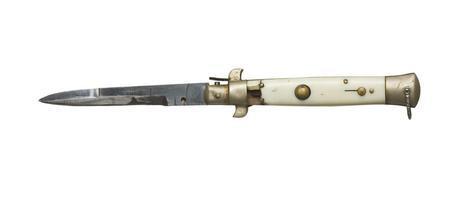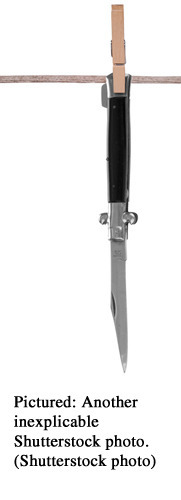What, Exactly, is a Switchblade?
Fiction just loves switchblades. That's why there's a whole section on them in The Weapons for Writers, the guide to firearms and knives I wrote that Writer's Digest will publish later this year. (Shameless plug: pre-order it here from Amazon.)
Ahead of that, I want to get a little primer on switchblades out there first. I was reading a thriller last night where a character popped open a switchblade to slit the throat of someone pinned in a car wreck. (Took a lot of guts to do that, chump.) There's nothing wrong with that passage, but it made me wonder if writers and readers know what it is that makes a knife a switchblade.
Switchblades' Two Key Features
When most people picture a switchblade, they imagine something like this Shutterstock pic:

That's a particular style of knife called an Italian stiletto, and it's a cosmetic thing. That a knife looks like that doesn't make it a switchblade.
By federal definition under the 1958 Switchblade Act, a switchblade sports two important features:
1) It contains a blade concealed inside a handle biased to come out of the handle.
2) The blade is released when a button, switch or other device on the handle is pressed. (You can see the big brass button on the handle in the pic above.)
If a knife doesn't have both of those features, it's not a switchblade. I italicized those bits because they separate switchblades from assisted openers. More on those later.
Switchblades: Mostly Dead
 In 1958, for reasons I go into in the guide, switchblades were prohibited by federal law. However, this only applied to interstate commerce. States could still determine their own switchblade laws, although most opted to restrict them. That means switchblades are, as Billy Crystal in The Princess Bride would say, only mostly dead across the U.S.
In 1958, for reasons I go into in the guide, switchblades were prohibited by federal law. However, this only applied to interstate commerce. States could still determine their own switchblade laws, although most opted to restrict them. That means switchblades are, as Billy Crystal in The Princess Bride would say, only mostly dead across the U.S.
Some states, such as New Hampshire, and municipalities allow civilian switchblade commerce and possession. Those new models are generally limited to short or custom runs. Most switchblades in circulation elsewhere are antiques.
More common are "automatic knives." That's the term for modern, manufactured switchblades. They're sold to military and law enforcement organizations. They look nothing like Italian stilettos. They're more in line with typical folding knives, with the exception that they contain those two points mentioned above. It follows that military and law enforcement characters would have no problem obtaining automatic knives. It's still accurate to call them "switchblades," but writing "automatic knives" instead will lend a nice touch.
It's Time to Phase Out Switchblades
Although they're popular in fiction, I think it's time to phase switchblades out for characters without access to automatic knives (i.e. not law enforcement or military characters). From a practical standpoint, they fail during hard use and don't always open as the springs wear out. Laws limit their availability to the average Joe and lowlife, leaving a pool of antiques in circulation to withstand the rigors of crime fiction. Switchblades' association with crime and fiction is left over from mid-20th century pop culture. Times - and technology - have moved on.
Assisted opening knives are the better option for fiction's protagonists and assorted bad guys. They function almost identically to switchblades without the legal restrictions. They gained popularity in the late '90s and were exempted in 2009 from the 1958 Switchblade Act.
I'll cover assisted opening knives in another post. In the meantime, you can pre-order The Weapons for Writers from Writer's Digest on Amazon here.
If you enjoyed this article, be sure to sign up for my free e-newsletter. You'll get helpful tidbits like this and more. I'll even give you a free e-book when you sign up. Keen!



